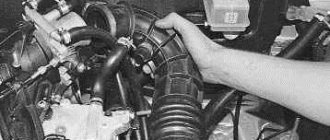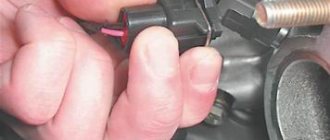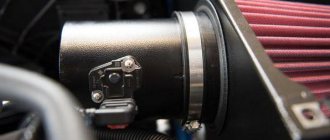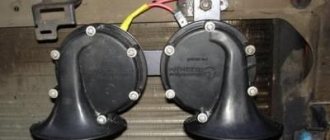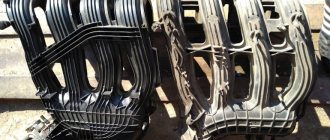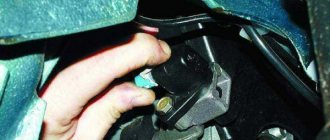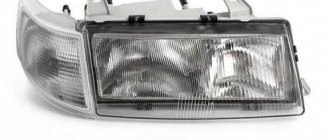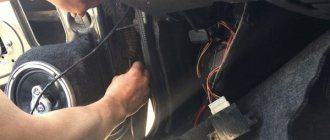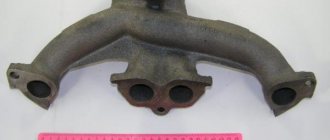I want to start this post with the question: “Do you need to install a spider?” Knowledgeable people say that the real increase in power is 3-4%, estimate the engine yourself based on your strength. This is minuscule.
But if you are building a really souped-up engine, be it a “classic” or a chisel, then this is some information for you. There are two types of spiders:
- 4-2-1 - long (pipes from each pair of cylinders fit into two thicker ones, and these two pipes fit into one)
- 4-1 - short (extended pipes from each cylinder converge into one under the car)
If you are interested in spiders on VAZ engines, then it is no secret to you that there are quite large power losses in the exhaust tract and it is possible to extract them, but this requires significant modifications to both the cylinder head (cylinder head) and the exhaust manifold. To minimize power losses, spiders are used in the exhaust manifold. A car engine spider is a pipe extension for each cylinder. This minimizes the impact on the operation of the adjacent cylinder. In general, the principle of operation of the spider is to improve purging and minimize the entry of burnt gases back into the cylinder. Think about it, if the cylinder purging gets worse, the power will drop (clogged exhaust, just close the exhaust with your foot). The spider allows not only to better vent the cylinder, but also to create a vacuum in front of the closed exhaust valve; when the valve opens, gases rush through the pipe a little faster than with a conventional manifold.
Let's return to objects, living or not. Spiders for VAZ engines are available for sale in two types - 4-1 and 4-2-1.
Benefits of the 4-2-1 and 4-1 spider
Now many drivers install a 4-2-1 spider in their cars in order to increase their power. Although modern cars have reached great heights, car enthusiasts do not stop there and continue to improve their cars. Those who are familiar with tuning and also do not want drastic changes in the engine design can improve their car by installing a 4 2 1 spider. This spare part itself is an exhaust manifold, and in this article we will describe its pros and cons. But first, let's figure out what the difference is in exhaust manifolds and what types they come in.
Spider Stinger
Spider Stinger is a component with which it is recommended to start tuning the engine in your car. This is due to its relatively low price, ease of installation and high degree of efficiency. Spider Stinger is a short, economical, easy way to increase engine power.
The spare part got its name “Spider” because of its specific appearance, which resembles the legs of a spider.
This impression is created due to the interweaving of pipes having different layouts and configurations:
All of the above modifications of spiders are made.
Types of collectors
The first type is a standard exhaust manifold. It is installed on most modern cars for more environmentally friendly operation and combines the manifold and catalyst. Its main job is to burn the remaining unburnt gasoline.
The disadvantage of such a manifold is poor exhaust gas permeability; the four pipes that come out of the engine are too thin. In addition, after leaving the engine, the exhaust gases rest against the catalyst honeycomb, and pressure forms in the manifold, as if the catalyst is strangling the engine. But since the catalyst has a certain service life and the price is quite high, car owners are trying to replace it with a spider (how can you check the catalyst?). The ideal exhaust system would be if the exhaust gases went straight out onto the street without any exhaust pipes or manifolds, but driving such a car would be neither possible nor legal.
Pros and cons of the spider 4-1
The second type of exhaust manifold is the 4-1 spider. The structure of such manifolds is similar to a factory catalyst, but the 4-1 spider has four pipes that come out of the engine with a larger diameter and the exhaust gas retention is less pronounced. As a rule, this type of collectors is cheaper.
Its structure is simpler and it is a simpler form. The design of such a collector involves the connection of four pipes into one thicker one and then a transition to the resonator. They are most often used on sports, high-revving engines, since the operating range of the 4-1 manifold is over six thousand revolutions.
Pros and cons of the 4-2-1 spider
And finally, the latest manifold design used in civilian, atmospheric tuning is the 4-2-1 spider. The purpose of such a spider is to lengthen the collector itself as much as possible and make sure that the exhaust gases leaving the engine touch and interfere with each other as little as possible.
The structure of such a manifold is made in such a way that the burnt gas-air mixture coming out of the first cylinder through pipes is connected to the fourth, and the second is connected to the third, and then these two pipes are connected into one.
Purpose
Exhaust manifolds are designed to remove exhaust gases; they also purify the combustion chamber, which stimulates its filling with a new portion of the mixture of fuel and air.
The exhaust manifold is an element of the exhaust gas removal system in a car that takes on a high temperature load; it can reach several thousand degrees.
Exhaust manifolds are attached, on one side, to the engine, on the other, to the catalyst, and if there is none, then directly to the exhaust pipe. Each cylinder has a separate gas exhaust sleeve (there are 4 in total), they all converge into one centralized outlet.
I installed the spider, do I need firmware?
Currently, there are a large number of manufacturers of sports spiders. They all claim that by installing a 4-1 spider or 4-2-1, the power of your four-cylinder engine will increase by up to 10%. This is confirmed by video clips and measurements on a dyno, but is it really so? Manufacturers don’t tell us a little, since replacing the standard manifold with a spider will disrupt the correct operation of the engine.
When a new car is produced, a standard program is installed in the engine control unit, which monitors exhaust gases and is set to a certain pressure in the exhaust manifold. When installing the spider, the pressure in the exhaust system changes and an engine error light appears on the dashboard. At the same time, the car begins to consume more gasoline and its power drops significantly. In order to avoid this, it is necessary to change the factory engine settings to the so-called euro two firmware, or even zero euro. Such firmware is more universal and can be easily installed at service stations where they do chip tuning. But absolutely identical motors simply do not exist, and in order to achieve maximum performance when installing a spider, you need to individually calibrate your engine.
Spider Subaru sound
A spider that creates a specific sound while the car is moving, especially when adding gas.
It’s easy to guess from the name that it imitates the unique, growing bubbling of the engines of the Japanese car brand.
This sound effect is created due to the specific configuration of the outlet pipes, which, according to the layout principle, are analogous to the previous modification, but have design differences. This is a pairwise method of connecting pipes - 2 right and 2 left, if you roughly divide the spider in half. They have a shorter convergence distance into 1 pipe.
The main difference between the Subaru sound spider is the ring formed by the sleeve after the 2 right pipes converge into one. It is this design feature that allows you to create the characteristic engine sound.
Our store catalog provides a wide selection of spiders, both for domestic cars and foreign cars. Here you can select exhaust manifolds for different types of engines. All models are made from high quality stainless steel. In addition to spiders of our own production, in our store you can buy the Team 80 (USA) model.
Source
Spider 4 2 1 VAZ 2110 8 valves
This product was chosen by 20 customers
For an 8-valve engine with a nut for 1-2 oxygen sensors.
After installing the spider, you will need to change the standard program and an oxygen sensor extension. The spider is installed complete with a Stinger direct-flow resonator without welding; in the case of a standard resonator, welding will be required.
Diameters:
- primary pipes - 38 mm;
- secondary - 43 mm;
- output - 51 mm.
Material: steel 08 ps cold rolled.
Power gain: 9.5 hp
When ordering in the cart, in the order explanation line, indicate for how many sensors you need a Spider for 1 or 2!
Weight, kg: 4.55 Dimensions, cm: 76 x 37 x 32 Volume, m3: 0.08998
Product delivery options
Note! Below are the shipping methods available specifically for this product. Payment options may vary depending on the shipping method. Detailed information can be found on the “Delivery and Payment” page.
Parcel by Russian Post
Available payment methods:
- Cash on delivery (payment upon receipt)
- Using cards Sberbank, VTB, Post Bank, Tinkoff
- Yandex money
- QIWI
- ROBOKASSA
Shipping throughout Russia. Delivery time is from 5 to 12 days.
Parcel by Russian Post 1st class
Available payment methods:
- Cash on delivery (payment upon receipt)
- Using cards Sberbank, VTB, Post Bank, Tinkoff
- Yandex money
- QIWI
- ROBOKASSA
Installing a spider on a VAZ 2114: subtleties of the process
An engine element such as spider 2114 is a type of exhaust manifold that provides the most optimal operating modes of the power plant.
Many motorists are thinking about replacing this part, because the original manifold on the VAZ 2114 is designed for operating modes in accordance with Euro-3 requirements, due to which the car loses more than 10 hp in power.
By simply replacing the base manifold with a spider, this situation can be easily corrected. We'll talk about how the spider itself works and how to install it below.
Ramp
Replacing the cathode collector on a VAZ 2110
The ramp is removed as an assembly with the fuel pressure regulator:
- It is necessary to disconnect the vacuum hose from the regulator.
- Using 2 open-end wrenches 17, unscrew the fittings securing the gasoline supply pipes to reduce pressure.
- Disconnect the ramp voltage connector.
- Using a screwdriver, unscrew the screw of the bracket for fastening the gasoline supply and outlet pipes and disconnect it.
- Using a No. 5 hexagon, unscrew the 2 screws for fastening the ramp.
- Pull the ramp in the axial direction of the injector from the seat, remove the ramp towards the left side of the hood.
Note: follow the direction of travel of the vehicle.
Replacement cathode collector for VAZ 2110
- Unscrew the nut from the left intake manifold bracket and loosen the lower bolt.
- Remove the bracket from it.
- Perform the same operation with the right bracket and remove it.
- Unscrew the 2 nuts from the eye stud.
Spider and its varieties
The main difference between the spider and the original VAZ exhaust manifold is:
- absence of sharp corners in the path of gases;
- multi-level direct-flow system (4-2-1 type);
- lack of internal components (it is they, first of all, that “bring” the engine’s performance to the Euro-3 standard and at the same time reduce its power).
In terms of its structure, the spider 4 2 1 2114 is a complex system of tubes connected to each other. As you might guess, there are 4 pipes coming from the engine itself, which at some distance combine into 2, and then into 1 exhaust pipe. This combination of tubes during engine operation creates air pressure differences, which contribute to maximum cleaning and purging of the cylinders and, as a result, increasing the overall engine power.
It should be noted that after installing the spider, the “environmental friendliness” of the car will decrease, and there will be no compliance with the Euro-3 standard. In all other respects, replacing this part will only benefit the car.
In addition to spiders of type 4 2 1, the action of which has already been described, you can also find spiders of type 4 1 in stores. The difference between them is that in the latter version, 4 tubes extending from the engine immediately turn into 1, bypassing the intermediate stage of 2 tubes.
Such spiders are intended exclusively for boosted engines and provide an increase in power compared to a standard manifold only at speeds of 6500 rpm or more. That is why the spider 4 2 1 on the VAZ 2114 is a better option than the spider type 4 1.
It should be noted that the entire modernization process will not be limited to just installing the spider. In addition to this, you will also need to install a direct-flow exhaust system, a resonator and remove the catalyst.
Thus, if you decide to replace the manifold, you will, in fact, have to replace the entire exhaust system. True, you can limit yourself to just replacing the catalyst with a resonator, but in this case the overall increase in power will be noticeably less (about 5 hp instead of 12-15 hp with a complete replacement of the exhaust system).
Why change the exhaust manifold?
Standard manifolds, in particular on VAZ cars, are made of cast iron. This metal can withstand high temperatures, but the problem becomes condensation that forms on the inner surface of the spare part. It provokes an oxidation reaction – corrosion, which gradually destroys the structure of the reservoir. Despite this, a standard spare part can last quite a long time; wear and tear is rarely the reason for its replacement.
Most often, the need to install a spider is due to practical considerations. The fact is that the standard collector does not work efficiently, does not allow the engine to develop full power - it suffocates it, while spiders solve the problem of collecting and removing exhaust gases more efficiently, therefore they are widely used in motor sports when tuning cars.
Installation of this simple, from a technological point of view, component is one of the most important stages in a set of measures aimed at increasing engine power.
What is needed for replacement
In order to install the spider on a VAZ 2114, you will need a minimum set of tools and accessories, namely:
- set of keys;
- angle grinder (grinder) - in some cases;
- cutting discs for angle grinders;
- welding machine - in some cases;
- WD-40 composition;
- new fasteners for the exhaust system;
- new lambda probe (equipped with an extended wire).
In addition, when installing the spider, you should also replace the exhaust manifold gasket.
As for choosing a spider manufacturer, you should give preference to the Stinger company, since its products are of high quality and have long been popular among motorists. In addition, you can purchase parts from other companies, but preference should be given to the middle or high price range. You should not purchase cheap spiders, as low-quality products can quickly fail.
How to make a replacement
The entire replacement of the VAZ 2114 spider takes place in several stages:
- Place the car on an overpass or pit, put the handbrake on and secure the wheels with stops (shoes).
- If the car has been running recently, let it cool down.
- Remove the crankcase protection.
- Unscrew the bolts securing the exhaust manifold pants to the catalyst inlet (to make unscrewing easier, they should be treated with WD-40 lubricant before starting work).
- If the replacement is partial, then leave the catalyst and muffler in place; if it is complete, then remove it.
- Unscrew the nuts securing the manifold to the cylinder head.
- Dismantle the “original” manifold and the gasket located under it.
- Install the spider instead of the standard manifold (if the spider matches the model, then it will definitely fit into its place). Before installation, you should place a new gasket under it.
- If the old fasteners are severely corroded, then new ones should be installed instead, preferably coated with copper or brass.
- If a partial replacement is performed, then you need to check the alignment of the spider pipe with the catalyst inlet. As a rule, the exhaust pipe of the spider is longer, so you will have to cut off and dismantle not only the catalyst, but also part of the exhaust pipe, instead of which a resonator should be welded.
- Connect the spider's output pipe to the resonator.
- If a complete replacement occurs, then the same operations are performed as in the previous paragraphs, but instead of the entire “original” exhaust system, a direct-flow exhaust system is installed.
After installing the spider, you will also have to replace the lambda probe (with a new one, with an extended wire). The completion of the entire modernization process will be the flashing of the ECU, which should be performed at a car service center. It will help register the new system in the computer as “standard”, and will also show the increase in power obtained as a result of the upgrade.
Self-replacement
Replacing the exhaust manifold of a VAZ 2110
- the car needs to be driven into the garage;
- hang a lamp with a safety light under the hood;
- before starting repairs, antifreeze must be drained from the tank;
- disconnect the battery terminals;
- take it out;
- put on a rack;
- disconnect the vacuum booster hose from the receiver;
- also disconnect the hoses of the electric pneumatic valve cover and the ramp pressure regulator;
- disconnect the chips of the throttle sensor, idle air control;
- disconnect the throttle valve cable;
- loosen the clamp on the air supply hose to the air flow sensor housing;
- disconnect it;
- loosen the clamps for attaching the hoses to the throttle pipe and ventilation of crankcase gases on the cylinder head cover;
Why do we need Spider?
“Spider” is the same manifold, but with separate removal of exhaust gases from the engine cylinders at the initial stage. The essence of the “Spider” is better purging and cleaning of the cylinders from exhaust gases due to pressure fluctuations in the exhaust system. To achieve the desired effect in the manufacture of the “Spider”, pipes of a certain length are used. Moreover, the pipes connected to the block head are installed in the order of engine operation.
There are two types of Spider currently sold on the market: 4-1 and 4-2-1. The difference between them comes down to the fact that in the first type, 4 pipes that are connected to the block head converge into one pipe, and it is already connected before the catalyst. The “spider” of the second type is different in that its 4 pipes first turn into 2 pipes, and those, in turn, into one, which is connected to the catalyst. In addition, the internal cavity of the “Spider” does not have the filling that is found in the standard manifold. This filling ensures compliance with the Euro-3 standard, and it also “presses” the VAZ 2114 engine.
The “Spider” type also influences the achievement of the desired effect. In order for pressure fluctuations in the exhaust system with type 4-1 to ensure good purging of the cylinders, the engine speed must be above 6500 rpm. That is, it is advisable to install such a “Spider” only on forced engines that provide high speeds.
Type 4-2-1 allows you to achieve the desired effect at low speeds, which makes it possible to use them on the VAZ-2114 even without modifications to the power plant.
It should be installed instead of a standard manifold, it will not particularly affect the operation of the engine; it will also require removing the catalyst and installing a resonator and a direct-flow exhaust system. In general, the entire exhaust system will have to be replaced. After such alterations, the VAZ-2114 will not meet any standards, but the car will become more playful. In addition, in the future there will be no need to replace a clogged catalyst, since it simply will not be in the system.
As for the disadvantages, the Spider provides a louder sound because the exhaust gases move through a direct-flow system. Many people like this sound, but when traveling long distances it can be very annoying. And the second drawback is that there can be no talk of any environmental friendliness.
But if you are tired of driving a VAZ-2114 with an engine that “drives” very calmly, then you should still install the “Spider”.
Installation of the Stinger 4-2-1 intake manifold on a VAZ 2110, 2111, 2112
I want to tell you how I finally installed the 4-2-1 spider from Stinger. The peculiarity of the installation, in my case, is that the spider was installed on a standard resonator and a corrugation (vibration compensator) was installed along with the spider.
0:404
1:909
Order
I ordered the spider 4-2-1. I ordered on the website stinger-shop.ru/. The following parts were purchased: 1. Intake manifold Stinger 4-2-1 16v -1500r 2. Gasket -100r 3. Oxygen sensor extension 150r 4. Double braid corrugation D55 L200mm 540r 5. Graphite ring with bolts -120r
1:1361
2:1866
Delivery was carried out by transport. Delivery was fast, the order arrived from Tolyatti to Taganrog in 9 days. Delivery of a parcel weighing 11 kg and volume 0.1 m cost only 550 rubles.
2:2232
Installation
As I already said, I planned to install the spider on a standard resonator and weld a vibration compensator corrugation. Why did I abandon the Stinger resonator? For myself, I can identify a number of reasons. 1. My standard resonator is made of stainless steel and is still in excellent condition, but the Stinger one is made of ordinary steel. 2. An important factor for me is noise, which the standard resonator should, in theory, cope better with. 3. I found information that a direct-flow Stinger resonator provides virtually no increase in power. By the way, the standard resonator is also essentially direct-flow, there are no labyrinths in it.
2:1130
3:1635
Well, the last but not least important factor is the price, and because... In any case, I was going to bother with welding the corrugation, then the “bolt on” installation did not particularly interest me and it was not advisable to overpay about 2000 rubles for this.
3:2039
The quality of the spider is very good, the plane of the flange is even, the welds are quite acceptable, there are no sagging on the internal surfaces of the pipes, it fits like original.
3:281
4:786
The plane is flat, the welding quality is not bad
4:870
5:1375
The installation went without any problems, the old manifold unscrewed easily, in order to pull it out I only had to remove the crankcase protection. The heat protection of the steering rack interfered a little; I had to bend it a little.
5:1754
6:2259
For convenience, I bent the heat shield of the rail, and after installation, I set everything back.
6:151
I was a little worried that the spider might not fit and that I would either have to drag it through the top and remove the strut and receiver, or through the bottom and remove the stabilizer. But despite the slightly lowered suspension, the spider easily climbed through from below.
6:560
7:1065
It doesn’t touch anywhere even with the thicker prior-stabilizer installed.
7:1227
8:1732
I didn’t regret that I immediately ordered an oxygen sensor extension; without the extension, the DC would definitely not have reached.
8:1919
9:2424
The resonator began to hang a little lower, but I think that it will not cling.
9:128
10:633
Comparison of collector drain and 4-2-1
10:694
11:1199
Corrugation installation
Flanges from the catalyst were welded to the corrugation, it turned out to be removable and if it fails there will be no problems with replacement. Since the spider is much longer than the collector drain, plus a long corrugation of 20 cm, I had to shorten the resonator a little.
11:1664
12:2169
Sound
I'll start with the main thing - the cabin has become quieter! Most likely the reason for this was not the spider itself, but the new manifold gasket. After dismantling the standard manifold, it was discovered that the gasket had blown, and on two cylinders at once.
12:424
13:929
When revving in place, the sound with the spider became more interesting and sporty. Under the hood you can't hear the exhaust sound at all, but from under the bottom you can hear a high-pitched, crackling, ringing sound. At the beginning, I decided that there was a little snag somewhere, but everything turned out to be sealed, and the high-pitched sound was made by the spider itself, in the place where there were 2 pipes. It is difficult to describe the sound in words, but I will try, and further, I will express my subjective opinion. Those who have driven eight-valve and six-valve engines have probably noticed that under load, the eight-valve engine in the cabin sounds somehow richer, sportier, and more beautiful. On the shestnar there is no distinct sound of the motor; it hums like a vacuum cleaner. With the spider, the sound of the engine under load has become richer and even more pronounced than with eight valves.
13:2226
The exhaust sound from the rear has become a little louder and bassier, but it is still not audible in the cabin, which is good.
13:190
Vibrations
I have already been asked several times why this corrugation is needed because there is a graphite ring and bolts with springs. I answer, the graphite ring does not dampen vibration at all, but only compensates for the movement of the engine relative to the exhaust system.
13:640
14:1145
Installing corrugations should significantly reduce vibrations and, as a result, overall noise. The longer the corrugation, the more effectively it should dampen vibrations, so a 20cm long corrugation was chosen. IMHO, the optimal length is 15-25cm. The effect of the corrugation is obvious, and it can be seen even with the naked eye. We start the car and look from the hole at the exhaust tract and see that before the corrugation it trembles more than after. In general, the vibration has become significantly less, which is definitely a necessary improvement.
14:1977
15:2482
16:504
The agony of choice
I think many have seen the comparison video on the engine stand of collectors 4-1 and 4-2-1
16:670
17:1175
Comparison of 4-1(line), 4-2-1(circles) and stock(stars)
17:1260
From this graph it clearly follows that the 4-1 collector is ahead of the 4-2-1 in a fairly large range.
17:1439
So why didn't I buy 4-1? I suggest analyzing the chart a little (don’t look at the green line yet). Please note that the 4-1 collector measurement schedule starts at 2500 rpm and I think this is not without reason. There is an opinion that up to 2500 rpm the 4-1 spider shows worse results than the 4-2-1. In this case, the reverse wave effect works, the very resonance that gives the increase. On the 4-2-1 spider measurement graph we just see a hump from 1800 to 2500 rpm. But how come this hump is also on the drain manifold?! Let me remind you that the stock manifold also has a 4-2-1 configuration, albeit less developed. And on the drain floors
, it just shows an increase in the same range as 4-2-1.
Let's go back to 4-1, since it only has one connection, and the resonance will only work in one range in the region of 3500 rpm. 4-2-1 has a second resonance in this place, after which the expected decline follows, which we see on the graph. From all of the above, it follows that the spider 4-1 up to 2500 rpm will be less effective, since it does not have the effect of the backward wave in this range and, accordingly, the graph will be linear. I allowed myself to fantasize a little and figured out what the 4-1 curve would look like in the range up to 2500 rpm. and painted it in green on our chart. 17:3674
All of the above is nothing more than assumptions and conjectures that are not supported by formulas or practical tests. So I would be happy to hear your opinion on this issue.
17:380
Results:
I'm very pleased with the result.
The cabin became quieter, the sound became more pleasant, vibrations decreased and, no less important, the car drove better. The arrival is noticeable, even without adjusting the firmware. Perhaps this is due to the fact that more evil firmware was uploaded a long time ago and the exhaust slightly revealed its potential. 17:938
By the way, a small bonus, the Stinger Spider is lighter than the standard version, I think the combat load was at least a couple of kilograms. In total, installing the spider cost 4,000 rubles, including the work, in my opinion it’s worth it.
17:1321
18:1826
19:2331
20:504
https://www.drive2.ru/l/6175488/
20:540 next article:
Installing a 54 mm throttle on a VAZ 2110, 2111, 2112
I have long planned to perform such a useful procedure as cleaning the throttle assembly, but somehow I never got around to it.
21:1367
Rating 0.00 [0 Vote(s)]
32481
What is needed to carry out the work?
You can carry out all the work yourself, having previously purchased everything you need. The alteration of the exhaust system can be partial, with the replacement of the catalyst with a resonator, but in this case, the “Spider” will not fully ensure its effectiveness, and a complete replacement of the exhaust system.
First of all, you need to buy the “Spider” itself for the VAZ-2114 car; it is better to take the 4-2-1 type. If the processing is complete, you will also need a resonator and a direct-flow muffler, and if it is incomplete, only a resonator. When replacing, the exhaust manifold gasket must be changed. You should only buy parts from reputable companies. Such a manufacturer is, for example, Stinger, but there are others.
Spider 16v
This section of our online store of tuning spare parts contains some of the most popular parts for modifying VAZ cars - tuned exhaust manifolds, or otherwise “spiders” (due to their similarity in appearance to insects). The spiders in this section are intended for VAZ cars that are equipped with sixteen-valve engines. These can be cars equipped with sixteen-valve engines either at the factory or converted on our own (one example is our VAZ 2113 sports car)
Purpose of spiders 16V
Stinger sport exhaust manifolds (spiders) from this section are intended to replace the standard exhaust manifold in the following cases:
— modification of the engine to increase power — “Stinger sport” exhaust manifolds were developed and tested on the engine stand.
— failure of the standard catalytic converter (catalytic converter), then in this case the spider will be doubly useful: it increases power and costs the replacement of a rather expensive catalyst.
Installation: most of the spiders in this section are installed without welding only with resonators from our Stinger sport production.” To make it easier to select components when completely replacing a standard exhaust system, we have combined exhaust manifolds, resonators and mufflers into kits based on car models. If you want to install a “Stinger sport” exhaust manifold with a standard resonator, you will need welding work, which is not difficult: you need to shorten the standard resonator and weld the mating flange.
Sequence of work
With all this at hand, you can get to work:
- We install the VAZ-2114 on the inspection hole and immobilize it. If the car is just from a trip, give the exhaust system time to cool. Remove the crankcase protection.
- We unscrew the bolts securing the exhaust manifold pants from the exhaust pipe of the catalyst and disconnect them. It is better to pre-treat the fastening bolts with WD-40.
- If the replacement is only partial, leave the catalyst and muffler in place for now. But with a complete replacement, we remove everything that comes from the collector’s pants from the VAZ-2114.
- Let's move on to the engine compartment. We unscrew the nuts securing the exhaust manifold to the block head, having previously treated them with WD-40.
- Carefully remove the standard manifold and the gasket located under it.
- Next, the Spider is installed. If the choice is made correctly, it will fall into place without problems. It is important not to forget to install a new gasket under it. If the old fastening nuts are heavily rusted, it is better to replace them with new ones, copper-plated or brass.
- Let's go under the car. In case of partial replacement, we try on the coincidence of the “Spider” with the exhaust pipe of the catalyst. Usually the “spider” is longer than the standard manifold, so the exhaust system will have to be shortened, which is why a grind is needed. machine (grinder) and welding machine. Then the catalyst is completely cut out. Along with the catalyst, it may be necessary to remove part of the pipe that goes behind it. And in its place a resonator is welded in, everything is first adjusted to the length.
- We connect the “Spider” to the receiving pipe of the resonator. This completes the partial replacement.
- For a complete replacement, we do the same as for a partial replacement, but with a new direct-flow system and resonator. That is, we hang a new exhaust system with a resonator on the car, take measurements, adjust it to length if necessary, connect and secure everything.
Some features
There are several nuances that should be taken into account when modifying the exhaust system of a VAZ-2114. The installed tuning manifold is wider in size, so it will touch the rubber pipe leading to the stove. To prevent this from leading to coolant leakage in the future, this pipe should be replaced with a new, longer one, and taken away from the manifold.
The lambda probe will also have to be replaced, since the hole for its mounting in the tuning manifold is lower than in the standard one, which is why this sensor with extended wiring is needed.
Also, the “Spider” is more voluminous at the bottom, so installing underbody protection is no longer possible.
The final stage of all this work is reflashing the electronic control unit, which will allow the new exhaust system to be “perceived” as standard. Also, flashing will allow you to “unleash” the full potential of the power plant after processing. It is better to perform flashing from knowledgeable specialists at a service station.
This is all the work related to the processing of the exhaust system of the VAZ-2114 car.
